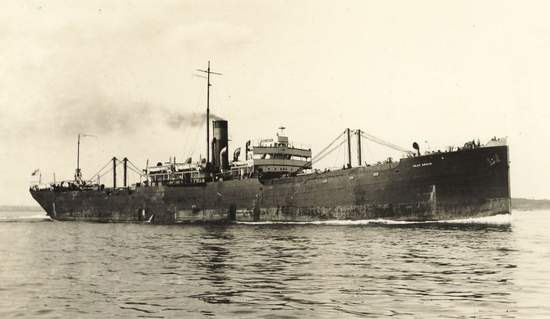Black Osprey
British Steam merchant

Black Osprey under her former name West Arrow. Photo Courtesy of Library of Contemporary History, Stuttgart
| Name | Black Osprey | ||
| Type: | Steam merchant | ||
| Tonnage | 5,589 tons | ||
| Completed | 1918 - Skinner & Eddy Corp, Seattle WA | ||
| Owner | Cairns, Noble & Co Ltd, Newcastle-upon-Tyne | ||
| Homeport | London | ||
| Date of attack | 18 Feb 1941 | Nationality: | |
| Fate | Sunk by U-96 (Heinrich Lehmann-Willenbrock) | ||
| Position | 61° 13'N, 18° 10'W - Grid AE 7988 | ||
| Complement | 37 (26 dead and 11 survivors). | ||
| Convoy | HX-107 (straggler) | ||
| Route | Baltimore – Halifax, Nova Scotia (3 Feb) - Newport, Monmouthshire | ||
| Cargo | 4500 tons of steel and trucks | ||
| History | Completed in February 1918 as West Arrow for US Shipping Board (USSB), Seattle. 1935 renamed Black Osprey for Black Diamond Lines Inc, New York. 1940 transferred to Britain and taken over by Ministry of War Transport (MoWT). | ||
| Notes on event | At 02.27 hours on 18 Feb 1941 the unescorted Black Osprey (Master Sidney Whayman Parks) was missed by one G7a torpedo from U-96 about 130 miles south of Iceland. The ship had been on her first transatlantic voyage under British flag in station #71 of convoy HX-107 when she lost contact to convoy due to bad weather on 10 February. The Germans assumed that the torpedo had hit but failed to detonate when the ship stopped, but unknown to them the funnel of Black Osprey had caught fire at 01.30 hours and the crew stopped the ship in very poor visibility to get the fire under control and this apparently caused the torpedo to miss. After 90 minutes they managed to put the flames out and proceeded, but the U-boat attacked again and fired one G7e torpedo at 03.25 hours. The torpedo struck on the port side between #1 and #2 holds, blew off the hatches and caused the ship to settle by the bow with a slight list to port. The master, 35 crew members and one gunner (the ship was armed with two machine guns) immediately began to abandon ship in all four lifeboats with some difficulties due to rough seas after sending a distress signal. Some men fell overboard and the port forward lifeboat was washed back on the fore deck which was already awash at that time. The weather was so bad that the survivors broke several oars in a heavy swell when they tried to row. The ship sank by the bow about 12 minutes after being hit by the torpedo. The U-boat then left the area without questioning the survivors as the ship was already identified by her distress signal. The lifeboats soon lost contact with each other, but the survivors in the port aft boat sighted flares from one of the other boats during the second night and spotted it the following morning. However, this was the last time they were seen as only the eleven occupants of the port aft boat were picked up by the Norwegian motor merchant Mosdale after being 53 hours adrift, at 06.00 hours on 20 February. The survivors were so exhausted and cold that they couldn’t move and had to be carefully hauled on board by lines tied around them by the chief officer of the Norwegian ship who had climbed down into their lifeboat. The ship had altered course after picking up the distress signal and even circled around for some considerable time in a fruitless search for the missing lifeboats before proceeding to Barry, where the survivors were landed on 22 February. The master, 24 crew members and one gunner were lost. | ||
| On board | We have details of 28 people who were on board. | ||
If you can help us with any additional information on this vessel then please contact us.
